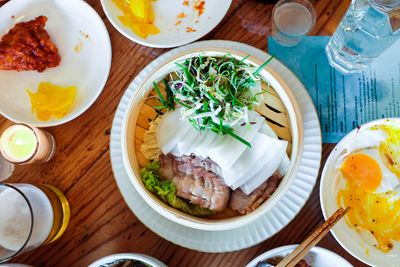Bimbap Recipe: A Flavorful Journey into Korean Cuisine
Guide or Summary:Understanding BimbapIngredients for the Perfect Bimbap RecipeStep-by-Step Bimbap RecipeServing Your BimbapVariations and TipsBimbap, a trad……
Guide or Summary:
- Understanding Bimbap
- Ingredients for the Perfect Bimbap Recipe
- Step-by-Step Bimbap Recipe
- Serving Your Bimbap
- Variations and Tips
Bimbap, a traditional Korean dish, is not just a meal; it's a vibrant and colorful experience that brings together various ingredients, flavors, and textures in one bowl. The essence of bimbap lies in its harmonious blend of fresh vegetables, protein, and rice, all topped with a spicy gochujang sauce. In this article, we will explore a detailed bimbap recipe that you can easily recreate at home, along with tips and variations to make it your own.
Understanding Bimbap
Bimbap, which translates to "mixed rice," is a staple in Korean households. It typically consists of a base of warm, white rice topped with an assortment of sautéed and seasoned vegetables, a protein source (like beef, chicken, or tofu), and a fried egg. The dish is often garnished with sesame seeds and seaweed, enhancing both its flavor and presentation. The final touch is a dollop of gochujang, a fermented red chili paste that adds a spicy kick.
Ingredients for the Perfect Bimbap Recipe
To create an authentic bimbap, you'll need the following ingredients:
- **Rice**: 2 cups of short-grain white rice (or brown rice for a healthier option)
- **Vegetables**: A variety of vegetables such as spinach, carrots, zucchini, mushrooms, and bean sprouts
- **Protein**: 1 cup of marinated beef (bulgogi), chicken, tofu, or an egg

- **Gochujang**: 2 tablespoons of gochujang (adjust to taste)
- **Sesame oil**: 2 teaspoons for flavoring
- **Sesame seeds**: 1 tablespoon for garnish
- **Seaweed**: Nori sheets or dried seaweed flakes for added texture
Step-by-Step Bimbap Recipe
1. **Prepare the Rice**: Rinse the rice under cold water until the water runs clear. Cook according to your rice cooker or stovetop instructions. Once cooked, let it sit covered for about 10 minutes.

2. **Sauté the Vegetables**: While the rice is cooking, prepare your vegetables. Heat a tablespoon of sesame oil in a pan and sauté each vegetable separately until tender. Season with a pinch of salt and set aside.
3. **Cook the Protein**: If using beef or chicken, marinate it in a mixture of soy sauce, sugar, garlic, and sesame oil for at least 30 minutes. Cook it in a hot pan until fully cooked. If using tofu, simply sauté it until golden brown.
4. **Fry the Egg**: In a separate pan, fry an egg sunny-side up or to your preference.
5. **Assemble the Bimbap**: In a large bowl, place a serving of rice at the bottom. Arrange the sautéed vegetables and protein on top of the rice in sections, creating a colorful presentation. Place the fried egg in the center.
6. **Add the Finishing Touches**: Drizzle with additional sesame oil, sprinkle sesame seeds, and add a spoonful of gochujang on top.

Serving Your Bimbap
To enjoy your bimbap, mix all the ingredients together in the bowl, ensuring that the gochujang and sesame oil are evenly distributed. The combination of flavors will tantalize your taste buds, making each bite a delightful experience. You can serve bimbap with a side of kimchi for an authentic Korean meal.
Variations and Tips
Feel free to customize your bimbap recipe by incorporating your favorite vegetables or proteins. For a vegetarian version, load up on more vegetables and opt for tofu or tempeh. You can also experiment with different sauces or toppings, such as spicy mayonnaise or avocado.
In conclusion, the bimbap recipe is a versatile and nutritious dish that showcases the best of Korean cuisine. Whether you're a seasoned cook or a beginner, this recipe is sure to impress your family and friends. Enjoy the process of creating your own bimbap masterpiece, and don’t forget to share your culinary creations!